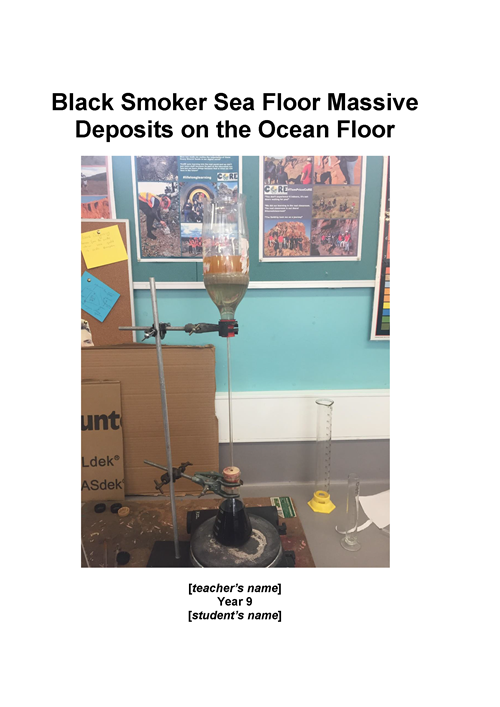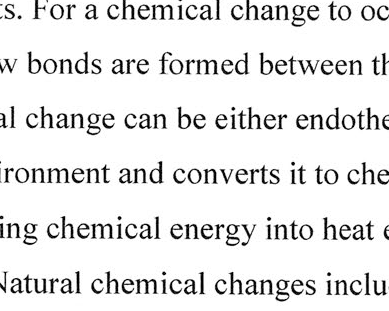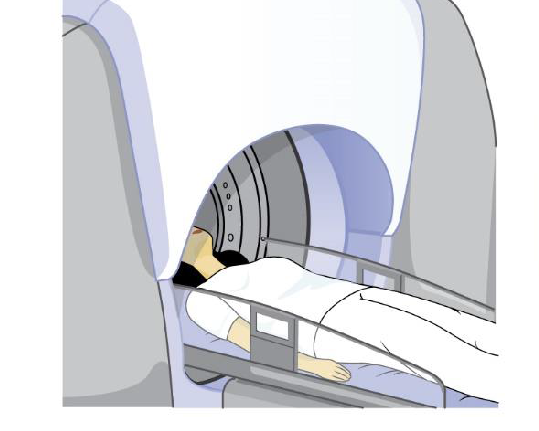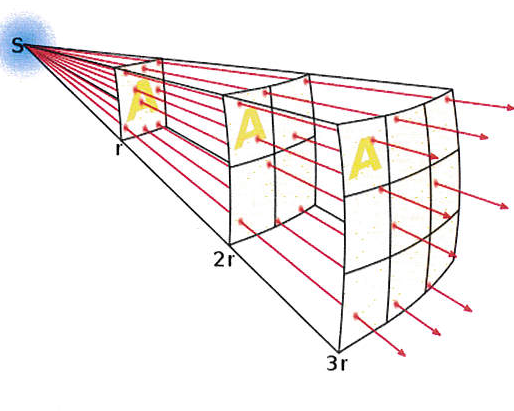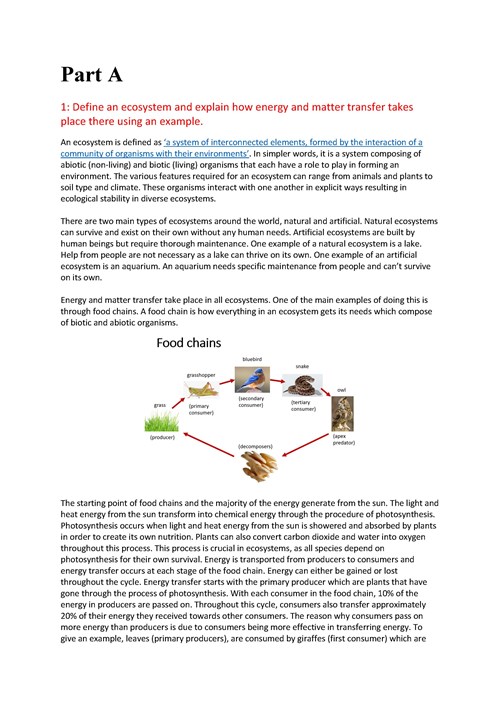- Home
- Resources
- Work samples
- Samples
- Earth Science Task – ABOVE
Science
Year 9
Above satisfactory
Hydrothermal vents
Summary of task
Over a period of eight weeks, students engaged in an integrated STEAM project designed to offer students insights into real-world industry applications and work experiences. Students were organised into ‘business units’ of a fictitious mining corporation tasked with undertaking relevant geophysical and geochemical investigations.
In this task, students chose to investigate the effect of ocean acidification on the formation of mineral depositions occurring near hydrothermal vents. They were asked to research the geological and chemical processes related to hydrothermal vents, plan and conduct a laboratory experiment that simulates these processes, and create a scientific report presenting the results and conclusions of their investigation. Working both independently and collaboratively, students were expected to organise their work using time management strategies to complete the project.
The project ideas and learning materials used in this work sample have been developed by the school in partnership with an organisation that provides STEAM resources and promotes a project-based approach to STEAM teaching.
Achievement standard
By the end of Year 9, students explain chemical processes and natural radioactivity in terms of atoms and energy transfers and describe examples of important chemical reactions. They describe models of energy transfer and apply these to explain phenomena. They explain global features and events in terms of geological processes and timescales. They analyse how biological systems function and respond to external changes with reference to interdependencies, energy transfers and flows of matter. They describe social and technological factors that have influenced scientific developments and predict how future applications of science and technology may affect people’s lives.
Students design questions that can be investigated using a range of inquiry skills. They design methods that include the control and accurate measurement of variables and systematic collection of data and describe how they considered ethics and safety. They analyse trends in data, identify relationships between variables and reveal inconsistencies in results. They analyse their methods and the quality of their data, and explain specific actions to improve the quality of their evidence. They evaluate others’ methods and explanations from a scientific perspective and use appropriate language and representations when communicating their findings and ideas to specific audiences.


 1
Annotation 1
1
Annotation 1
Uses understanding of heat transfer mechanisms to explain geological processes associated with formation of hydrothermal vents 2 Annotation 2
Creates diagram illustrating how convection causes divergent movement of tectonic plates
-
Annotations
-
1
Annotation 1
Uses understanding of heat transfer mechanisms to explain geological processes associated with formation of hydrothermal vents -
2
Annotation 2
Creates diagram illustrating how convection causes divergent movement of tectonic plates
 1
Annotation 1
1
Annotation 1
Describes origin and composition of minerals and states why ‘black smokers’ may be of interest to mining industry 2 Annotation 2
Explains how human-induced emissions of carbon dioxide contribute to ocean acidification 3 Annotation 3
Demonstrates understanding of chemical reactions and the concept of acidity 4 Annotation 4
States purpose and aim of investigation, clearly establishing its economic interest
-
Annotations
-
1
Annotation 1
Describes origin and composition of minerals and states why ‘black smokers’ may be of interest to mining industry -
2
Annotation 2
Explains how human-induced emissions of carbon dioxide contribute to ocean acidification -
3
Annotation 3
Demonstrates understanding of chemical reactions and the concept of acidity -
4
Annotation 4
States purpose and aim of investigation, clearly establishing its economic interest
 1
Annotation 1
1
Annotation 1
Creates annotated diagram of experimental setup to illustrate 'black smokers' in model geological system 2 Annotation 2
Identifies and categorises key variables
-
Annotations
-
1
Annotation 1
Creates annotated diagram of experimental setup to illustrate 'black smokers' in model geological system -
2
Annotation 2
Identifies and categorises key variables
 1
Annotation 1
1
Annotation 1
Identifies experimental risks and lists appropriate rules of conduct
-
Annotations
-
1
Annotation 1
Identifies experimental risks and lists appropriate rules of conduct
 1
Annotation 1
1
Annotation 1
Provides detailed step-by-step instructions to describe experimental procedure
-
Annotations
-
1
Annotation 1
Provides detailed step-by-step instructions to describe experimental procedure
 1
Annotation 1
1
Annotation 1
Exploits software functionality to digitally embed raw data in report and provides clarifying remarks (see last page for actual data) 2 Annotation 2
Creates flowchart describing in detail major stages of experiment
-
Annotations
-
1
Annotation 1
Exploits software functionality to digitally embed raw data in report and provides clarifying remarks (see last page for actual data) -
2
Annotation 2
Creates flowchart describing in detail major stages of experiment
 1
Annotation 1
1
Annotation 1
Creates diagrams to illustrate alterations made to the experimental setup 2 Annotation 2
Describes how they collaborated with other groups of students to speed up processing of results
-
Annotations
-
1
Annotation 1
Creates diagrams to illustrate alterations made to the experimental setup -
2
Annotation 2
Describes how they collaborated with other groups of students to speed up processing of results
 1
Annotation 1
1
Annotation 1
Presents results in table including clarifying remarks 2 Annotation 2
Creates graph displaying combined results from several groups of students including clarifying remarks
-
Annotations
-
1
Annotation 1
Presents results in table including clarifying remarks -
2
Annotation 2
Creates graph displaying combined results from several groups of students including clarifying remarks
 1
Annotation 1
1
Annotation 1
Uses annotated photographs to illustrate and describe processes occurring at different stages of the experiment
-
Annotations
-
1
Annotation 1
Uses annotated photographs to illustrate and describe processes occurring at different stages of the experiment
 1
Annotation 1
1
Annotation 1
Identifies trend in data and recognises that it does not support hypothesis 2 Annotation 2
Refers to evidence from other investigations to confirm unexpected trend 3 Annotation 3
Speculates about causes for unexpected results 4 Annotation 4
Relates experimental results to real-world situation and reflects on its impacts on society
-
Annotations
-
1
Annotation 1
Identifies trend in data and recognises that it does not support hypothesis -
2
Annotation 2
Refers to evidence from other investigations to confirm unexpected trend -
3
Annotation 3
Speculates about causes for unexpected results -
4
Annotation 4
Relates experimental results to real-world situation and reflects on its impacts on society
 1
Annotation 1
1
Annotation 1
Reflects on learning process 2 Annotation 2
Reflects on benefits of collaboration 3 Annotation 3
Suggests alterations to experimental method that would improve accuracy of results
-
Annotations
-
1
Annotation 1
Reflects on learning process -
2
Annotation 2
Reflects on benefits of collaboration -
3
Annotation 3
Suggests alterations to experimental method that would improve accuracy of results

